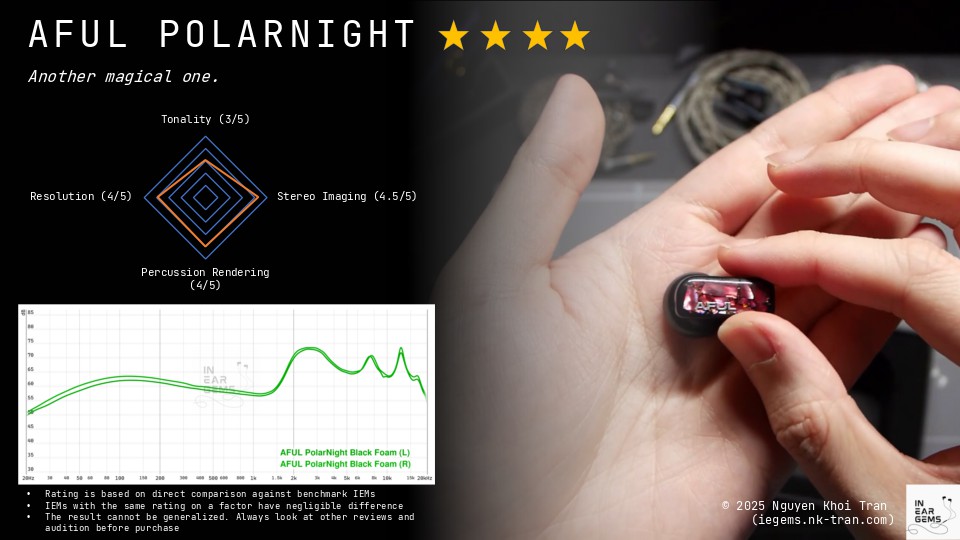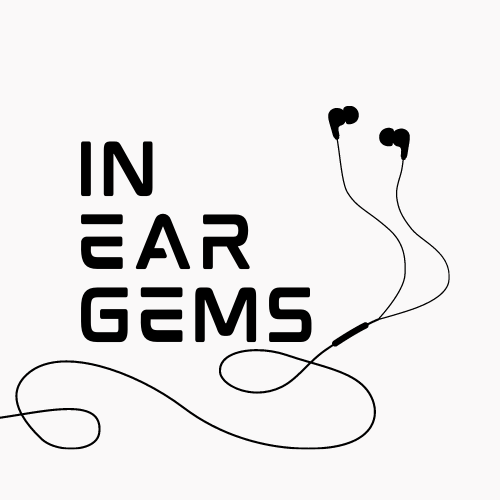AFUL PolarNight - Another magical one
In the age of wireless technology and miniaturised computers, nothing seems more archaic than wired IEMs and big bulky MP3 players that audiophiles love so much. But what if I tell you that there is yet another niche within this niche of a hobby?
Enter the flathead earbuds.
Do you remember the godawful earphones back in the days of cassette tapes, CDs, and early iPods? The ones with big flat heads just hanging outside the ear canals rather than going all the way in like In-ear Monitor (IEMs)? Yes, those are flathead earbuds. When IEMs dominate the personal audio market, it is easy to believe they have killed off the earbuds for good. Surprisingly, they have been hanging around, being lowkey in the background, cherished by a small and passionate community, away from the warp speed of the “ChiFi” IEM market. Do-it-yourself community (DIYers) and manufacturers like Venture Electronics, FiiO, Dunu, NiceHck kept the form factor alive and pushed the boundary.
And you know what? Earbuds have improved. A lot. In fact, when I received some of your questions about recommendations for a new pair of IEMs, I thought you would be better served with a pair of modern earbuds instead. Do you want a wide, open soundstage? Earbuds. Do you want to avoid the annoying pressure build-up in ear canals? Earbuds. Do you want that new and fancy “bone conduction” effect where the soundwave hits your ear conchas in addition to the eardrums? Earbuds. So on and so forth.
Today, let’s look at PolarNight and see whether the stellar IEM maker AFUL has what it takes to push the earbuds technology forward.
Forewords
- What I look for in an IEM is immersion. I want to feel the orchestra around my head, track individual instruments, and hear all of their textures and details. I’m not picky about tonality, as long as it does not make the orchestra, violin, cellos, and pianos sound wrong.
- I rate IEMs within with a consistent scale from 1 (Poor) to 3 (Good) to 5 (Outstanding). An overall ranking of 3/5 or above is considered positive.
- Ranking list and measurement database are on my IEM review blog.
- The terminology for subjective impressions in this review is based on the Audio Wheel for reproduced sound defined in the technical report ITU-R BS.2399-0
- This review is based on a review sample provided by Hifigo (Thank you!). I have no affiliation with or financial interest in Hifigo and AFUL.
- The unit retails for US$180 at the time this review was published. Unaffiliated link: Hifigo Web Store
In the box
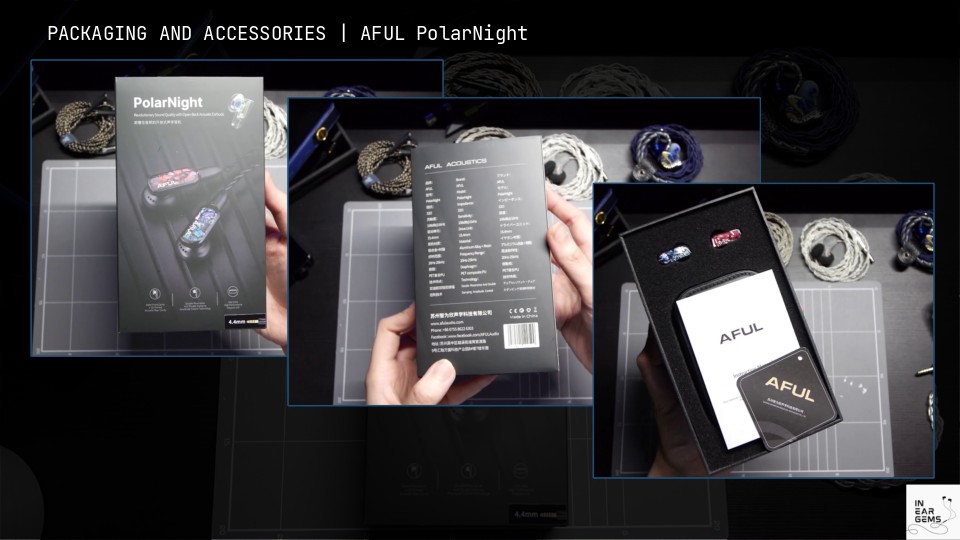
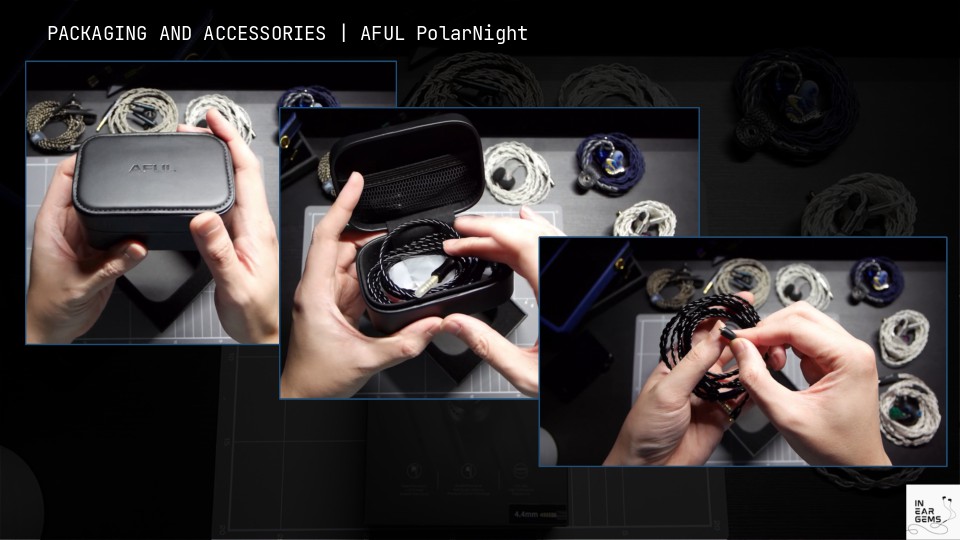
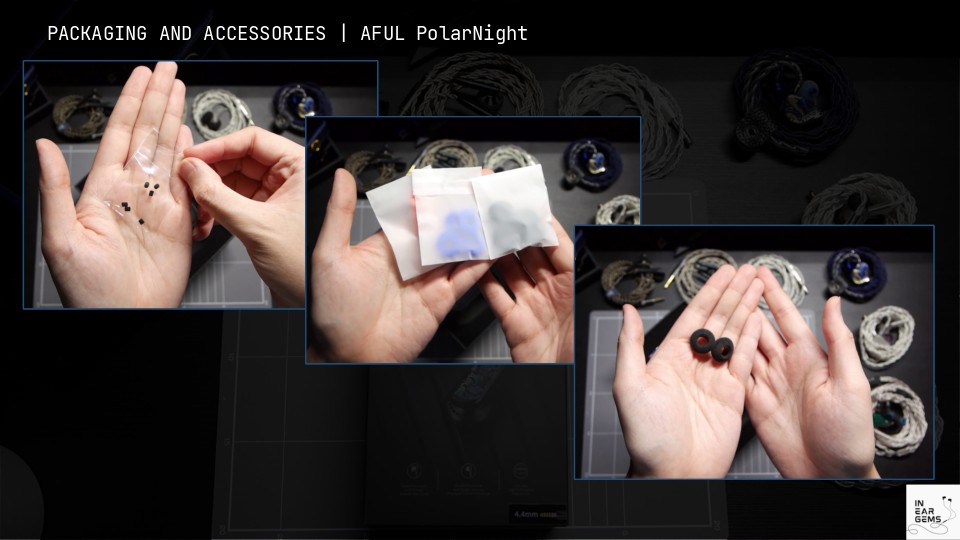
General Information
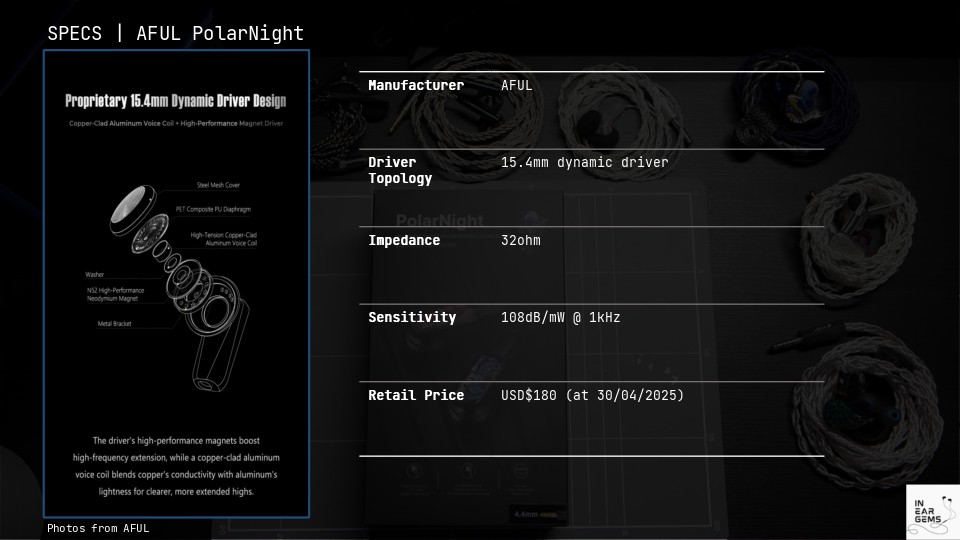
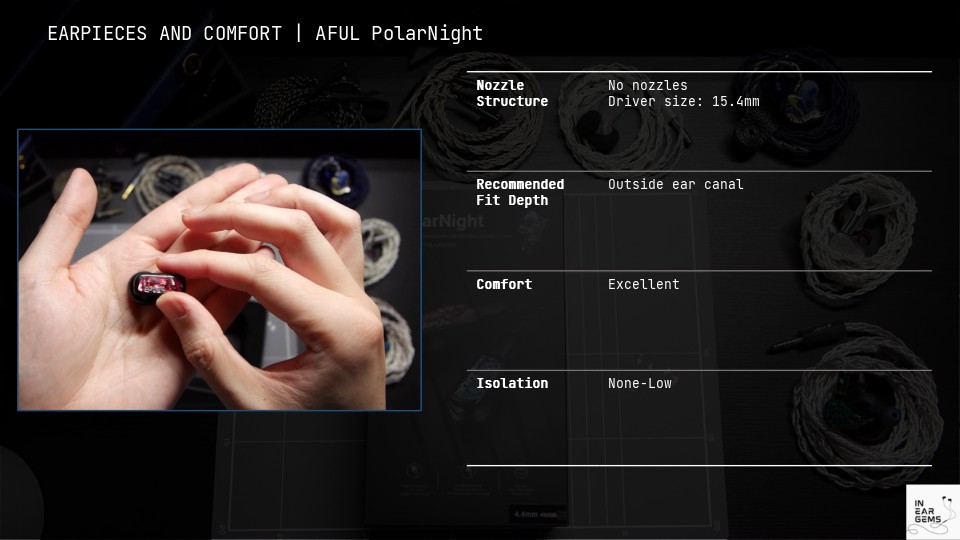
By now, I think we geeks in the personal audio community have developed quite an expectation when we look at a new release from AFUL because, let’s face it, this Chinese audio boutique has not released a single dud since its first international release, the Performer 5 hybrid IEM. So, what does AFUL bring to the flathead earbuds table?
First, let’s discuss the spec sheet. PolarNight is powered by an in-house 15.4mm driver with a 32ohm impedance and a sensitivity of 108dB/mW @ 1kHz. This driver size is larger than the 14.8mm and 14.2mm drivers used by other manufacturers, meaning PolarNight would fill the concha area of your ears more fully, which could be better or worse depending on your ears’ structure. The earpieces are constructed from a combination of metal and resin components and support replaceable cables via MMCX connectors.
If you have followed AFUL, your question would be: “Everything seems pretty standard. Where is AFUL’s usual geekery?” That was also my first question when hearing about PolarNight. AFUL’s answer starts with taking a step back and looking at the entire landscape of flathead earbuds to understand their perennial weaknesses and using these as the starting point of the design process. In particular, AFUL went after three key limitations:
- Lack of sub-bass and weak bass response in general. This lack of bass leads to an unrefined low-end response.
- Lack of vocal expressiveness. In particular, the 15.4mm drivers and 14.2mm drivers used by flathead earbuds tend to concentrate most of the energy around the 500Hz-2kHz region, neglecting the lower midrange (down to 250Hz) and upper midrange (up to 4kHz). As a result, voices tend to sound boxy, lacking the right kind of warmth and vibrancy.
- Limited soundstage height and resolution. This limitation is caused by a combination of the overly concentrated response in the midrange region, poor treble extension, and limitations of the large full-ranged drivers in general.
The general direction that AFUL took to address these problems is the same path that DIYers and other manufacturers have been pursuing: improving the driver and fine-tuning the acoustic structures to squeeze the most out of that driver whilst masking its problems. For the driver, AFUL uses an in-house 15.4mm driver containing a PET+PU diaphragm driven by N52 magnets and copper-clad aluminium voice coil. The drive is housed in a metal cavity attached to a resin structure containing 3D-printed channels for dampening the driver and amplifying bass response. If you feel a bit of deja vu, you are not alone. We see the same design principle, enabled by the same high-precision 3D printing capability we have seen in almost every AFUL release.
If we are more specific, the system that AFUL implemented this time in PolarNight is called the “Dual-Resonance, Dual-Damping Amplitude Control System.” As the name implies, PonarNight has two sets of vents. The first one, Resonance Control Damping A, is in the vent holes on the metal cavity holding the driver. The other vent, Resonance Control Damping B, is at the top of the resin part of the shells, which is connected to a long resonant chamber that runs within the shells and connects to the empty “room” at the back of the driver. This B vent is closed with foam, which you can pull out and replace. AFUL provides a bag of spare foams, and if you are adventurous and handy with a pair of tweezers, no one can stop you from experimenting with different damping foams.
Experience
But enough with the spec sheet and theory. How does it feel to use PolarNight?
To answer this question, I have used PolarNight as my daily driver for over a month, perhaps much longer than anticipated by both Hifigo/AFUL and myself. I spent around six to seven hours a day, 5 days a week, with these earbuds in my ears to provide background music at work. The comfort, as you might have guessed based on the long hour, is stellar. I have been unable to wear IEMs that long because my inner ears would get itchy and uncomfortable after around one hour. Because PolarNight does not touch the ear canals, I have no itchy ears. I also found PolarNight to be more comfortable than other modern earbuds due to a larger driver and lighter construction. For example, FiiO’s FF series utilises smaller 14.2mm drivers, which means they don’t fit as snuggly in my ears. Combining this issue with the heavy metal construction means the earpieces would slowly slide out from the sweet spot in my ears and require adjustment. The thick stems of PolarNight and the way they sit closer to the ears compared to the classical MX5 shells commonly used by DIYers, so I found that PolarNight locks into place better and requires less adjustment. All in all, it has been a smooth ride.
The sound is where things get a bit complicated.
The out-of-the-box experience was not stellar. The first song I listened to with PolarNight was Shivers by Ed Sheeran, and it was, for the lack of a better word, brutal. When Ed reached high notes, I found myself winching. You might think that it is sibilance (a.k.a., that piercing hiss that you hear when singers pronounce “s,” “sh,” “th,” “f,” “z,” or “v”), but that’s not the case. In fact, PolarNight tames the 5-8kHz region quite well and is less “hot” than other AFUL IEMs. No, it’s the energy in the upper midrange region around the 3-4kHz region that is a bit out of balance. This means that when singers stay in the lower register, everything is fine and dandy. However, when they reach higher notes, you will find those higher notes just a bit louder than expected and thus a bit uncomfortable. If you recall, AFUL’s design goal was to lift this region. So, in that sense, you might say, “Job well done.”
So, is it the end of AFUL’s earbuds ambition? Throwing in the towel after five minutes would be rather unprofessional, so I pressed on with the rest of my playlist. After all, I can always adjust the tuning further with my foam collection, I reasoned. So I pressed the play button and settled down.
And you know what, I’m glad I did because, after a few more songs, I got used to the upper midrange of PolarNight to the point it was no longer a problem. I could even see some upsides of this tuning choice. I think the lower midrange prevented this tuning from becoming a trainwreck. Despite emphasising the upper midrange, PolarNight does not make voices hollow because it has enough lower midrange to balance out. I enjoy the classics from Johnny Cash and Marty Robbins with PolarNight quite a bit because these earbuds make their voices sound natural, with authority. For these gentlemen, the upper midrange emphasis of PolarNight highlights the texture and details in their voices in a way that makes recordings sound “high-resolution.” Even tape hiss sounds more “real” somehow.
Another evidence of PolarNight’s tuning success is how it handles pianos, cellos, and orchestras. Usually, when we deal with a hollow midrange (like the ones usually provided by “full-Harman” IEMs), cellos lose authority and start to sound like violas, and pianos sound hollow and imbalanced. It was not the case here. I thoroughly enjoyed my classical library with PolarNight.
So, what’s the verdict about PolarNight’s tonality? I find it more intense than I expected. But at the same time, it never sounds unnatural, hollow, honky, or nasally. The focused energy at 3-4kHz lends an incredible sense of clarity to most voices and instruments, besides those that have already been mixed a bit too hot. Overall, **I’d say PolarNight is one of the better-tuned flathead earbuds, but it is somewhat a regression on the tuning front within the AFUL family.
Let’s move on from tonality to the agglomerate of sonic characteristics known as “technical performance.” This is where PolarNight shines the brightest. SNAPPY is the best word I can think of to convey the entire “technical performance” of PolarNight. Note attacks across the frequency spectrum start with a great sense of incisiveness. No delay, no hesitation, no blurriness, no “loosey-goosey”. When many note attacks appear very close to each other, such as in a busy section or a quick bassline, those attacks remain crisp and distinct. It’s not a grossly exaggerated claim to say this 15.4mm dynamic driver of PolarNight can rival the incisiveness of some high-performing full-BA setups. Yes, I did my A/B tests.
This incisiveness of PolarNight creates tangible benefits to my listening experience. In the midrange region, the incisiveness leads to a great sense of clarity and separation (i.e., the so-called “macro resolution”). This means that I can separate and follow any instrument or voice in most busy recordings with little effort. When I sit back and listen to the whole, I can hear individual parts rather than a homogeneous blob of sound. You would think that the wide open soundstage of earbuds plays a significant role in this advantage, and you would be right. However, if a pair of earbuds is not incisive enough (like most of my DIY buds), you can hear distinct blobs that sit further from each other on the soundstage, yet you still have difficulty distinguishing instruments within each blob. Combining the great instrument separation with the “forced clarity” baked into PolarNight’s upper midrange emphasis, you have quite a “high-resolution” sonic picture.
In the bass region, the incisiveness of PolarNight leads to a tactile and snappy bass line. AFUL’s effort in improving the bass response paid dividends here, as PolarNight provides just enough bass and even sub-bass to create a sense of power behind every bass attack. Large drums in the OST of the Ghost of Tsushima, such as “The Fate of Tsushima”, feel large and “tight”, with a great sense of power and “realness.” I also like to revisit Bon Jovi’s classics because of how PolarNight renders the drums. It’s toe-tapping, exhilarating, and makes me forget about life for a while. Anyway, I digressed.
Stereo imaging is another area where PolarNight does very well. Yes, most earbuds sound wide and open because they do not block the ear canals. But at the same time, they don’t position instruments within this large soundstage with finesse because they tend to lack treble extension. It was not the case with PolarNight. I first noticed its precision when listening to an ASMR video recorded with a Neumann KU100. PolarNight was so precise that I could detect subtle shifts in the sound’s height, angle, and distance. This level of precision nearly matches my daily driver IEM, the AFUL Cantor. Moreover, due to the earbud’s form factor, the sound sources can appear further from my head with PolarNight, so I would say PolarNight reproduced the ASMR track even more accurately than Cantor.
Where PolarNight falters in on the stereo imaging aspect is the (lack of) illusion of depth, especially of the sound coming from the front of the head. I tested its capability in FPS gaming and found myself a bit disappointed. While the sounds from the sides and back have excellent positioning, and I can easily detect distance, height, and angle, the sounds from the front feel like they are on the same plane very close to the face. In other words, PolarNight does not provide me with an orbital soundstage that acts as a “radar” like some IEMs. I suspect a bit of extra bass response could help.
Before moving on, conclude our discussion with modding. I guess your burning question now is, “If you whine about the upper midrange that much, why don’t you just change the foam?” For dear readers who have not seen modern earbuds before, let me explain: whilst earbuds can be worn as-is (“naked”), most put a layer of foams or silicone rings on the driver. Foams dampen sound and improve the seal between earbuds and the ears, so foams play a significant role in tuning earbuds. AFUL paired PolarNight with “Donut” foams, which have a hole in the middle for the sound to come through unimpeded. Of course, we can replace doughnut foams with full foams to dampen the high-end and increase the perceived amount of low-end. However, I found that all of my full foam does not provide enough change in the upper midrange whilst dampening the snappy response of PolarNight in the bass region. When I measured PolarNight’s response, I detected a slight drop in bass response at the same input signal level. Moreover, because my ears got used to the upper midrange of PolarNight, I found foam swap unnecessary. Of course, my ears are not yours, so it does not hurt to try a foam swap if possible.
Selected Comparisons
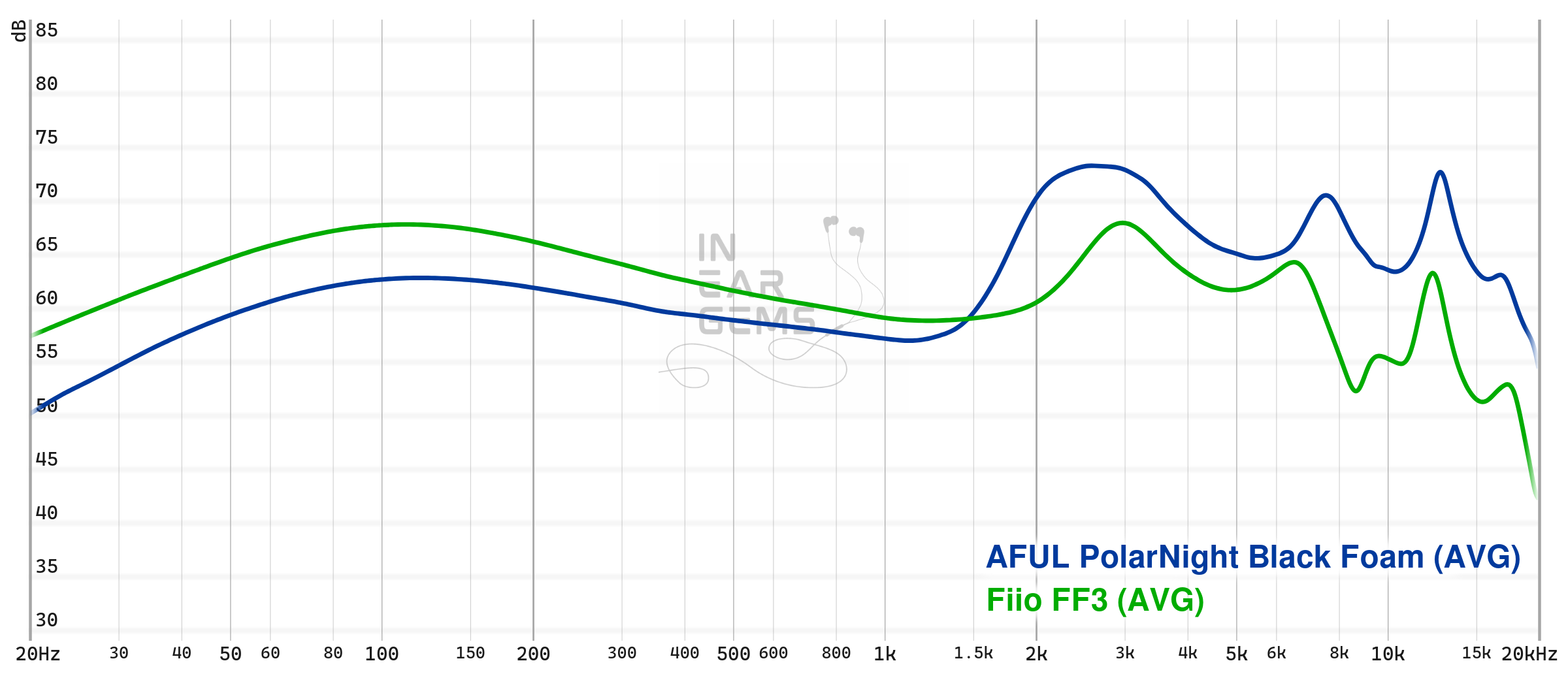
PolarNight vs FiiO FF3: These buds couldn’t be more different. FF3 has a smaller driver and very heavy metal shells, so I constantly adjust it in my ears. Meanwhile, PolarNight has a larger driver and better-fitting shells. Regarding the sound, FF3 is tuned towards a bassy, warm(er) sound signature, whilst PolarNight is tuned more “neutral.” Both earbuds have outstanding bass quality, but they approach the bass response in different ways. FF3 gives you a big, bold, “woolly” bass response that gives the impression that the bass comes from a larger source, with a stronger “air pushing against ears” sensation. PolarNight is more agile, tactile, and snappy in its bass response. FF3 has better forward positioning of the sound and a better illusion of soundstage depth. PolarNight has superior clarity, resolution, and precision of stereo imaging on the side channels. I think FF3 is still quite competitive against PolarNight, and you can have both as they go for different sound signatures.
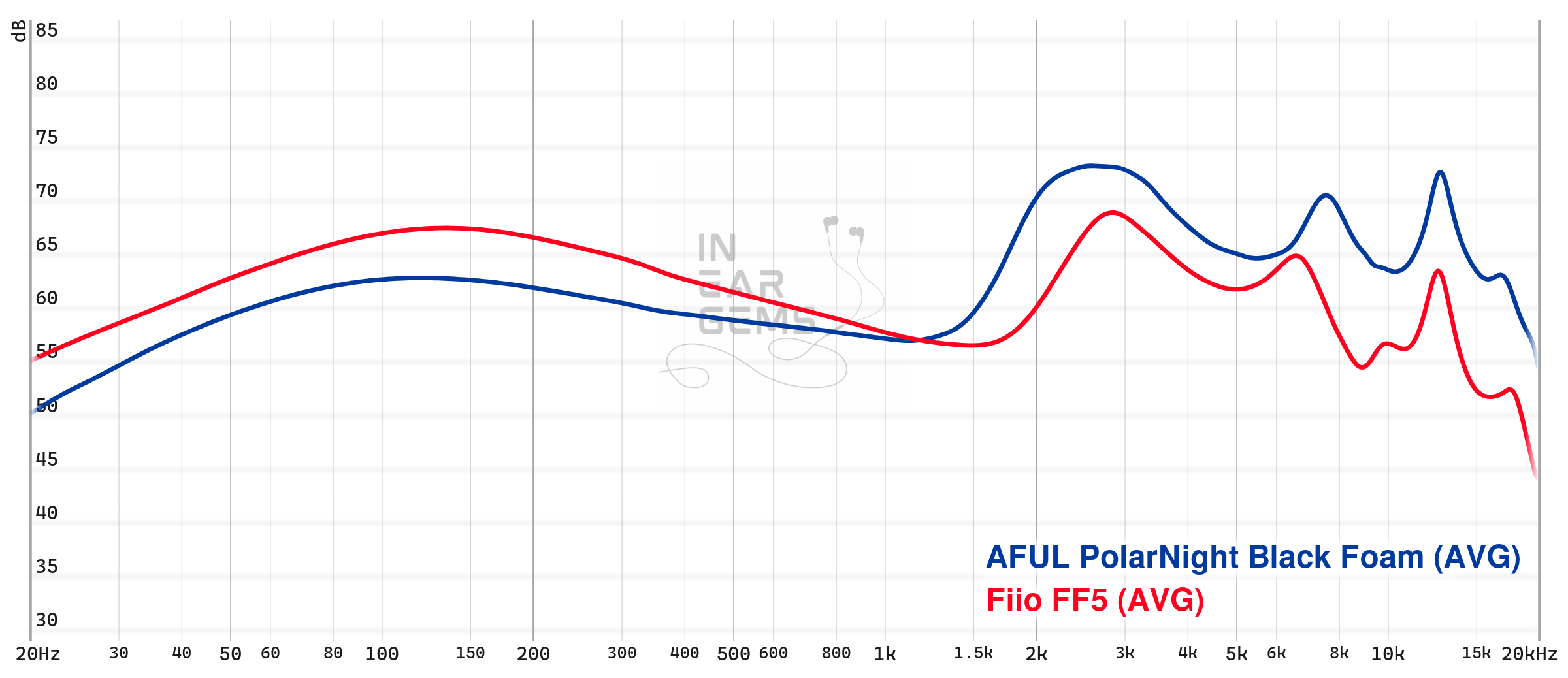
PolarNight vs FiiO FF5: On paper, a less bassy and more agile version of FF3 would be the perfect counter to PolarNight. In practice, FF5 is not competitive. I tested FF5 with various foams and silicone rings, but I always found it to sound more hollow than PolarNight. For example, when I listened to The Last Recordings by John Denver with FF5, I found John’s voice to be the dominant element in the mix, yet his voice sounded a bit thin. Switching to PolarNight immediately makes the recordings lively, as the band and the bass guitar fill in more around John’s voice, which has more weight and warmth. Unless you prefer a thin, focused midrange, I must give this round to PolarNight.
PolarNight vs Dunu Alpha 3: Alpha 3 puts up a much better fight. Both IEMs render John Denver’s voice almost identically in terms of tonality. All of my complaints about the upper midrange of PolarNight can be applied directly to Alpha 3 (and vice versa, to be fair). Where PolarNight pulls ahead is the mix’s richness and the bass response’s quality. Like FF5, Alpha 3 focuses on the midrange, perhaps at the expense of other parts of the spectrum. While Alpha 3 can put up a decent fight against PolarNight in more easygoing recordings, it lacks the impact and power to come close to PolarNight’s performance in energetic tracks like The Fate of Tsushima. Alpha 3 is boring in these recordings, and no amount of my foam swapping changed the situation.

PolarNight vs Serratus: First thing first: Serratus is significantly more challenging to drive than PolarNight. I need to turn my R6 Pro Max player to 42 with Serratus to have the same loudness level as PolarNight at 31. Regarding sonic performance, it is surprising how closely Serratus match PolarNight in terms of bass response. Whilst Serratus loses out slightly in terms of snappiness of the bass attacks, it offers a thicker, more muscular midbass and lower midrange. Serratus is also noticeably more “trebly” than PolarNight, which helps convey the position cues and ambience baked into large orchestral recordings. I would say Serratus convey a grander stereo image with Ghost of Tsushima OSTs. However, Serratus’s “trebly” tuning is also its Achilles’ heel. Simply put, it can be sibilant. John Denver, for example, sounds more pleasant with PolarNight. Other than tonality, Serratus trades blow with PolarNight on every aspect of technical performance.
One interesting observation: Serratus’ tuning feels more like AFUL’s house sound (restrained upper midrange, pushing treble to limit) than AFUL’s earbuds.
PolarNight vs Performer5+2 (P7): You ask “why?” I say, “Why not?” The first difference is the level of noise isolation P7 offers, and the soundstage feels more tightly packed. I also feel myself breathe out a sigh of relief when putting P7 on because this is the level of upper midrange that I feel at home. But after this impression, I’m surprised that I miss the clarity and incisiveness of PolarNight, particularly in the midrange region. The bassline of PolarNight is also more snappy and tight, whilst P7 sounds thicker and more “muscular.” On the plus side for P7, it has a superior treble response, evidenced by the nice sense of ambience and space in the Ghost of Tsushima OST album. Overall, I’m still amazed by the technical performance of these 15.4mm drivers AFUL put in PolarNight.
Detailed Analysis
Timbre and Tonality

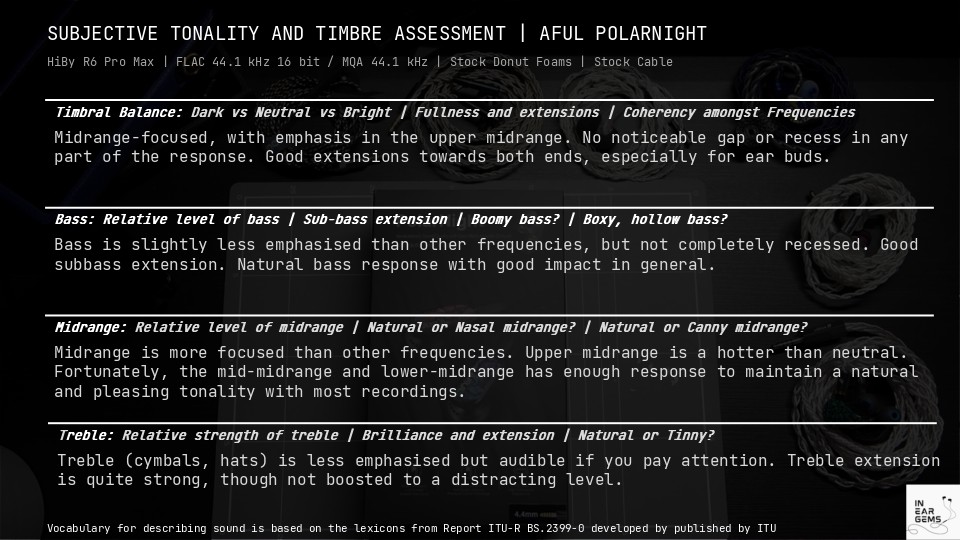

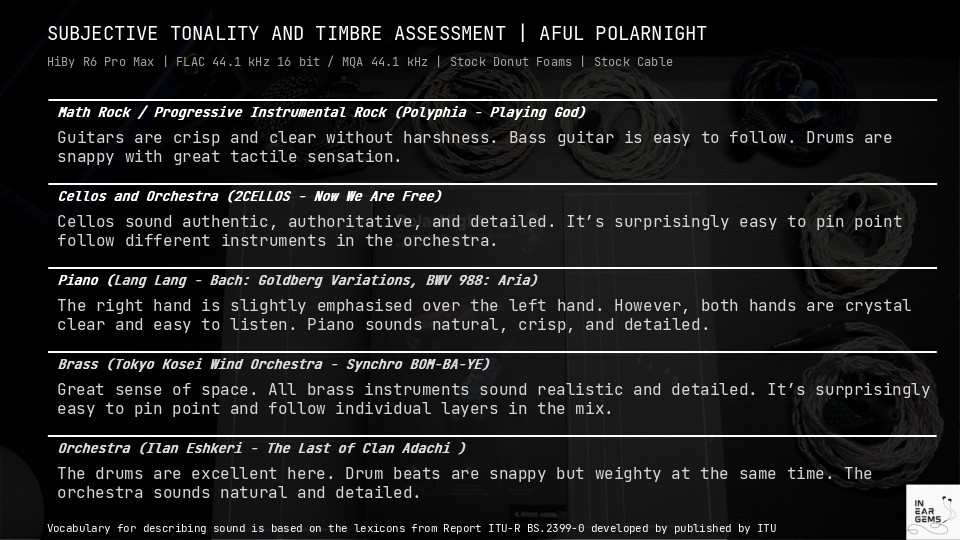
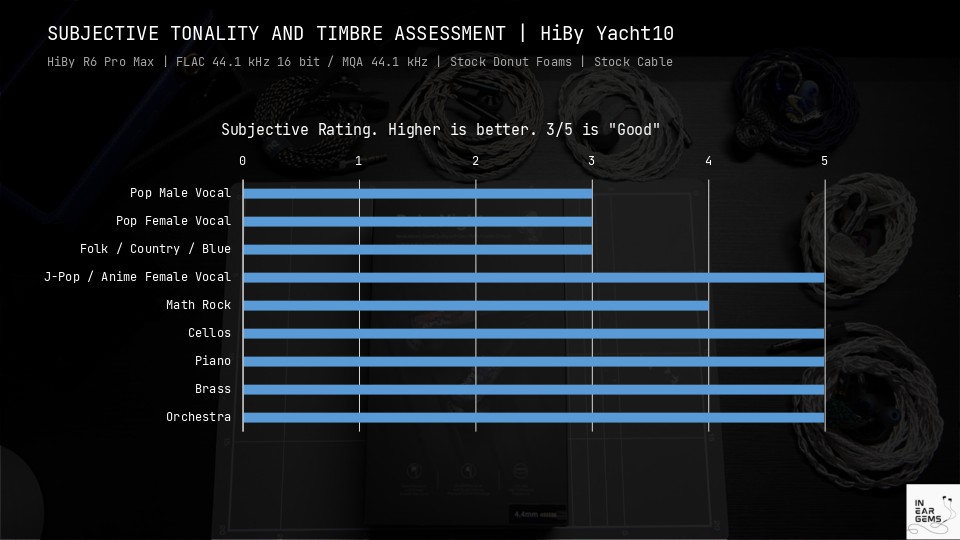
Bass and Dynamic
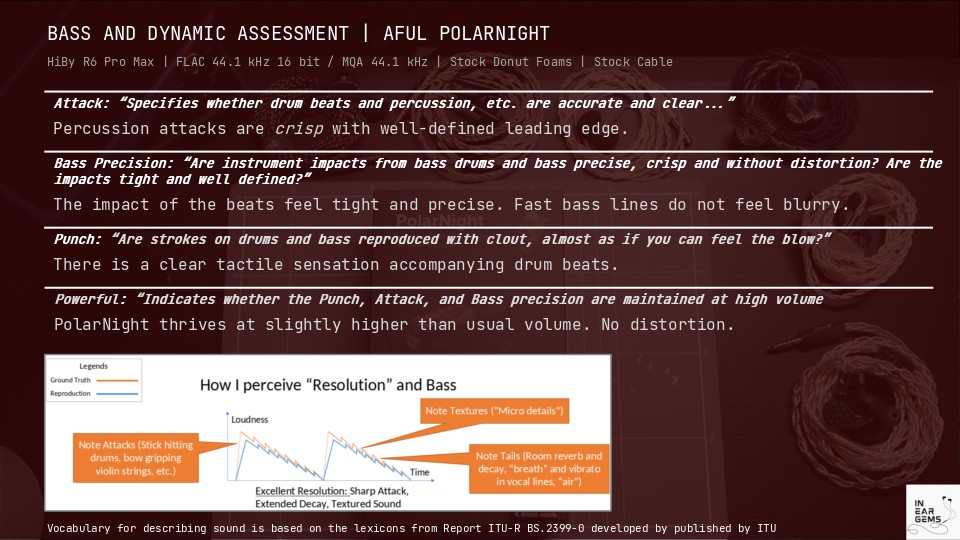
Resolution and Details
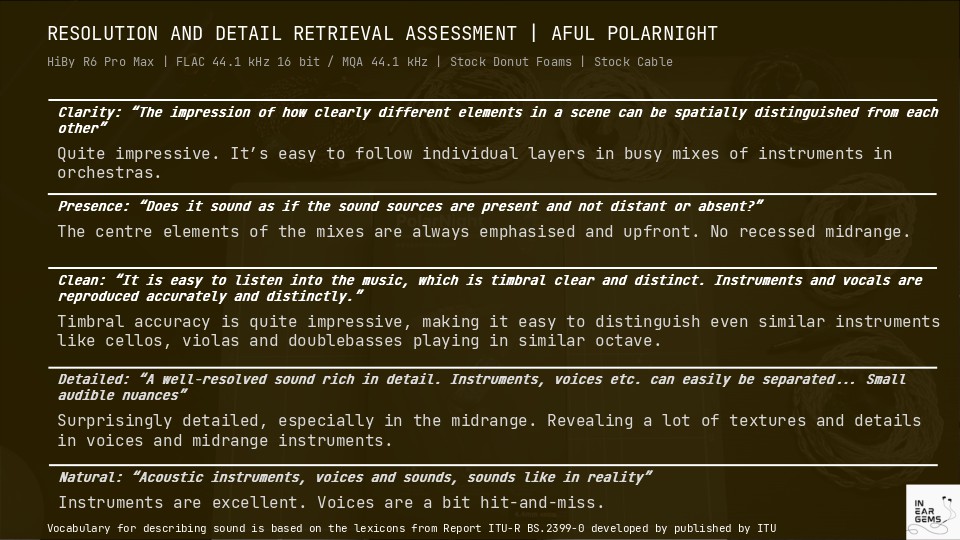

Soundstage and imaging
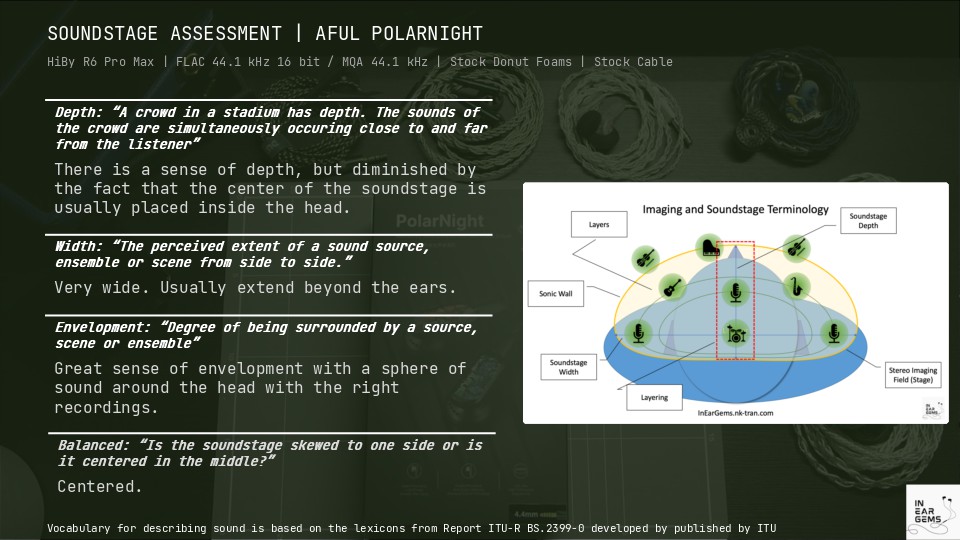
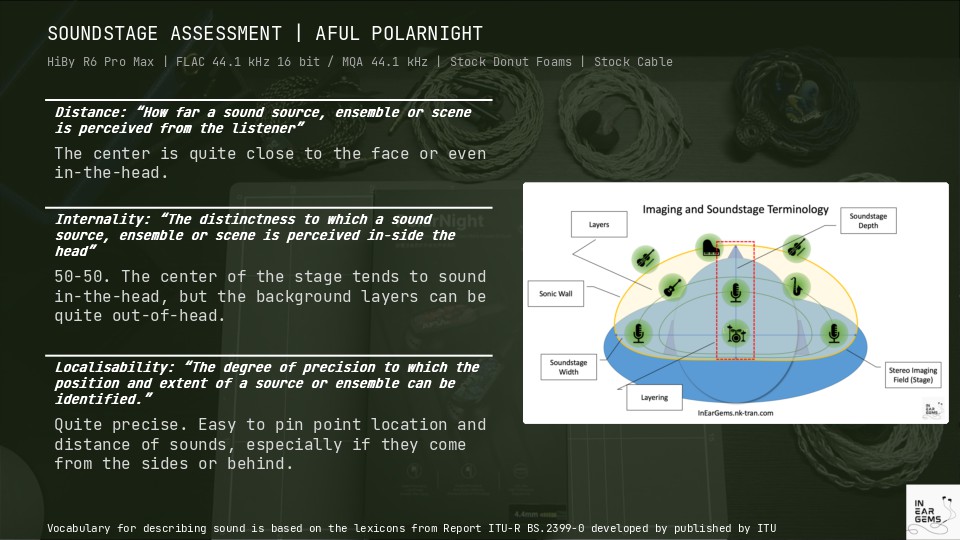
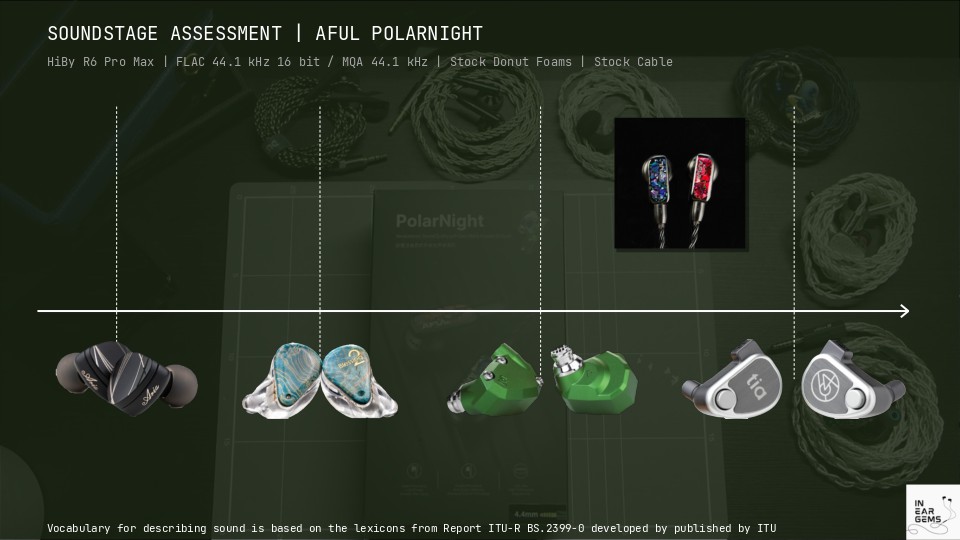
Conclusions
As I concluded my (very) long assessment of PolarNight, the conclusion is pretty straightforward: these are some special earbuds. Yes, the tonality has some hiccups, but that’s not uncommon or particularly problematic in the world of earbuds. Where AFUL makes its mark with PolarNight is in technical performance. It’s not every day that I find earbuds that are competitive in technical performance and bass quality compared to good IEMs. In fact, it wouldn’t be exaggerated to say that PolarNight stands at the forefront of mass-produced earbuds.
But here is the elephant in the room: the DIYers. Whilst PolarNight cruised through my A/B tests against mass-produced earbuds, it faced quite a tough competition against some of the more prominent DIY earbuds. So, as a consumer, the question for you is whether you should go with top-notch factory-made earbuds where you arguably have a higher degree of consistency or test your luck with hand-made-in-small-batch earbuds. Only you and your priorities can answer this question. In any case, AFUL PolarNight and the earbuds form factor receive a high recommendation from this reviewer.
